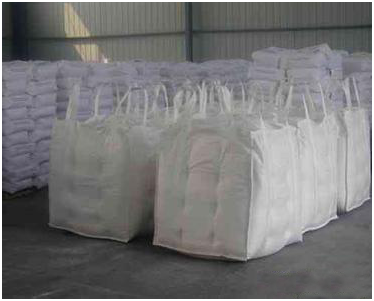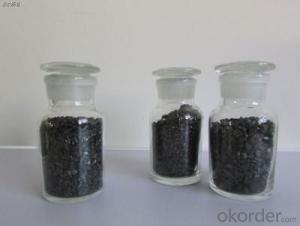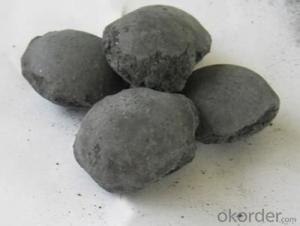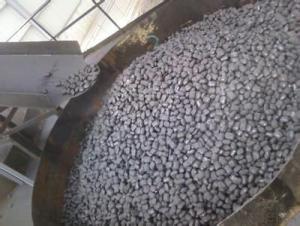Recarburizer of Graphitized Petroleum Coke
- Loading Port:
- Qingdao
- Payment Terms:
- TT OR LC
- Min Order Qty:
- 10 m.t
- Supply Capability:
- 300000 m.t/month
OKorder Service Pledge
OKorder Financial Service
You Might Also Like
Recarburizer Application:
- Lower the impurities in the cast iron,
- Choose the right recarburizer can lower the casting cost.
- Recarburizer is essential auxiliary additives for production of high quality steel .
- Also it can can be used as additive for produce other product like brake pad used as friction materials;
- High quality recarburizer is after graphitizing process,under high temperature,the arrangement of carbon atoms in microstructure of graphite.
so call it graphitization ,graphitizing can lower the impurities in recarburizer, increase the carbon content, lower the sulfer content.
Product categories:
At present China have 3 Type Recarburizer:
- Graphite powder ,the dust power of graphite electrode
- Calcined Petroleum Coke part of domestic steel factory use it as recarburizer.
- Graphitized Petroleum Coke ,as recarburizer used for steel casting


- Q: How does carbon dating work?
- The age of organic materials, such as plants, animals, and human remains, can be determined through the scientific technique known as carbon dating. This method relies on the continuous formation of carbon-14, a radioactive isotope of carbon, in the atmosphere due to cosmic rays. Carbon-14 is absorbed by living organisms through photosynthesis or consumption. The ratio of carbon-14 to stable carbon isotopes (carbon-12 and carbon-13) in the atmosphere remains relatively constant as living organisms maintain equilibrium by exchanging carbon-14 with the atmosphere through respiration or consumption. However, when an organism dies, it no longer takes in carbon-14, leading to the decay of existing carbon-14 at a predictable rate. Carbon-14 has a half-life of approximately 5,730 years, meaning that after this period, half of the carbon-14 in a sample will have transformed into nitrogen-14. By measuring the remaining carbon-14 in a sample, scientists can calculate the time that has passed since the organism's death. The carbon dating process involves several steps. Initially, a sample is collected from the organic material to be dated, which can include wood, bones, or textiles. The sample is then prepared for analysis by eliminating any impurities and converting it into a suitable form for measurement. Subsequently, the sample is exposed to a high-energy radiation source, such as a particle accelerator or a nuclear reactor. This exposure causes the carbon atoms in the sample to emit beta particles, which are small bursts of energy. These particles are detected and measured using sensitive instruments, enabling scientists to determine the remaining amount of carbon-14 in the sample. Finally, this information is utilized to calculate the age of the organic material. By comparing the ratio of carbon-14 to carbon-12 in the sample to the known ratio in the atmosphere, scientists can estimate the elapsed time since the organism's death. Carbon dating is an invaluable tool for archaeologists, paleontologists, and geologists. It allows for the accurate determination of the ages of ancient artifacts, fossils, and geological formations. This technique has revolutionized our understanding of human history and the natural world, providing us with invaluable insights into the past.
- Q: What is the role of carbon in the formation of diamonds?
- The creation of diamonds heavily relies on carbon, as it is the sole element accountable for their existence. Diamonds are generated in the deep recesses of the Earth's mantle, amidst extreme temperature and pressure. When carbon atoms face immense heat and pressure, they undergo a process called graphitization, which entails rearranging their atomic composition and transitioning into a crystal lattice structure, ultimately leading to the formation of diamonds. The process commences with carbon-rich materials, such as organic matter or carbon-bearing minerals, encountering the intense heat and pressure prevalent in the Earth's mantle, generally at depths ranging from 150 to 200 kilometers. In such circumstances, the carbon atoms within these materials are compelled to bond in a distinctive manner, producing the rigid, three-dimensional lattice structure that characterizes diamonds. The formation of diamonds necessitates specific geological conditions, namely temperatures surpassing 900 degrees Celsius and pressures surpassing 725,000 pounds per square inch (50,000 atmospheres). These extreme conditions are typically present in regions where ancient tectonic plates collide or during volcanic eruptions that bring diamonds to the Earth's surface. The ability of carbon to form robust covalent bonds with other carbon atoms is what facilitates the transformation into diamonds. Each carbon atom establishes four sturdy covalent bonds, giving rise to a tetrahedral structure. This formidable bonding empowers diamonds with exceptional hardness, rendering them one of the toughest substances known to humanity. To sum up, carbon plays a vital part in the formation of diamonds, undergoing graphitization amid immense temperature and pressure to create the distinct crystal lattice structure that grants diamonds their extraordinary properties. Without carbon, the creation of diamonds as we presently comprehend them would be unattainable.
- Q: How do fossil fuels release carbon into the atmosphere?
- Combustion, a process in which fossil fuels like coal, oil, and natural gas are burned for energy, results in the release of carbon into the atmosphere. This carbon, which had been trapped underground for millions of years, is converted into carbon dioxide (CO2) gas. During combustion, the carbon and hydrogen atoms present in fossil fuels react with oxygen from the air, producing not only CO2 but also water vapor (H2O) and heat. The released CO2 is then emitted into the atmosphere, where it acts as a greenhouse gas. The burning of fossil fuels in various sectors such as transportation, electricity generation, and industrial processes plays a significant role in the escalating levels of atmospheric CO2. The continuous extraction and rapid burning of these fuels have led to a substantial increase in the concentration of CO2 in the Earth's atmosphere over the past century. This rise in atmospheric CO2 is a primary driver of climate change, as CO2 acts as a heat-trapping gas, contributing to the greenhouse effect. The greenhouse effect occurs when the Earth's atmosphere retains the heat radiated from the surface, resulting in a global temperature increase. Therefore, the release of carbon into the atmosphere from fossil fuels is a major concern due to its significant role in climate change and the subsequent environmental and societal impacts. To address these effects, there is a growing global effort to transition towards renewable and cleaner energy sources, reduce fossil fuel consumption, and implement sustainable practices.
- Q: How does carbon impact the prevalence of ocean acidification?
- Carbon impacts the prevalence of ocean acidification primarily through the process of carbon dioxide (CO2) absorption by seawater. Increased levels of atmospheric CO2, mainly caused by human activities such as burning fossil fuels and deforestation, lead to more CO2 being dissolved in the oceans. This excess CO2 reacts with seawater to form carbonic acid, which lowers the pH of the ocean and increases its acidity. This increased acidity has detrimental effects on marine life, particularly organisms with calcium carbonate shells or skeletons, as it hampers their ability to build and maintain their structures. Overall, the high levels of carbon in the atmosphere contribute to ocean acidification, which poses significant threats to marine ecosystems and biodiversity.
- Q: How many electrons does carbon have?
- Carbon has six electrons.
- Q: What are the consequences of increased carbon emissions on tourism industry?
- The tourism industry is greatly affected by the significant consequences of increased carbon emissions. One prominent result is the deterioration of natural landscapes and ecosystems that attract tourists. Carbon emissions contribute to global warming, which leads to higher temperatures, melting glaciers, and more frequent extreme weather events like hurricanes and droughts. These environmental changes can cause the destruction of iconic landmarks, such as coral reefs or national parks, which are often the main attractions for tourists. Additionally, increased carbon emissions contribute to air pollution, which can have negative effects on air quality in popular tourist destinations. This poor air quality can lead to respiratory problems and other health issues for both tourists and local populations, making these places less desirable to visit. Moreover, the degradation of natural environments due to carbon emissions can also harm wildlife, resulting in a decline in biodiversity. This loss of wildlife can reduce the appeal of ecotourism destinations, which heavily rely on diverse flora and fauna. Furthermore, the tourism industry heavily depends on transportation, which is a major source of carbon emissions. The use of fossil fuels in planes, ships, and cars contributes to the industry's overall carbon footprint. As countries strive to decrease their carbon emissions, they may enforce stricter regulations or impose taxes on air travel, making it more expensive and less accessible for travelers. This can impact the number of tourists visiting different destinations and impede the growth of the tourism industry. Lastly, the consequences of increased carbon emissions extend beyond environmental factors. Climate change and extreme weather events can disrupt travel plans, resulting in cancellations and financial losses for both tourists and businesses in the tourism industry. Additionally, destinations that heavily rely on winter tourism, like ski resorts, may face challenges due to shorter snow seasons or inconsistent snowfall patterns caused by climate change. In conclusion, increased carbon emissions have dire consequences on the tourism industry. From the degradation of natural landscapes and ecosystems to the impact on air quality and wildlife, the effects of carbon emissions can discourage tourists from visiting certain destinations. Furthermore, the industry's reliance on transportation contributes to its overall carbon footprint, potentially leading to increased costs and limited accessibility for travelers. Climate change-related disruptions and financial losses further exacerbate the challenges faced by the tourism industry.
- Q: What are the effects of carbon emissions on the stability of alpine ecosystems?
- Carbon emissions have significant effects on the stability of alpine ecosystems. Increased carbon dioxide levels contribute to higher temperatures, leading to changes in snowpack, glacial melt, and altered precipitation patterns. These changes disrupt the delicate balance of alpine ecosystems, impacting plant and animal species' distribution, abundance, and phenology. Additionally, increased carbon emissions contribute to ocean acidification, which affects the health of marine ecosystems that alpine ecosystems rely on for nutrients. Overall, carbon emissions threaten the stability and biodiversity of alpine ecosystems, with potential cascading effects on global climate systems.
- Q: How does carbon impact the energy balance of the Earth?
- The energy balance of the Earth is primarily influenced by carbon, which plays a significant role in the greenhouse effect. Carbon dioxide, a greenhouse gas, is emitted into the atmosphere through both natural processes and human activities such as the burning of fossil fuels and deforestation. The greenhouse effect occurs naturally when specific gases in the atmosphere trap heat from the sun, preventing it from escaping back into space. This process is essential for maintaining a suitable temperature for life on Earth. However, excessive carbon emissions have intensified the greenhouse effect, resulting in global warming and climate change. When carbon dioxide and other greenhouse gases accumulate in the atmosphere, they trap more heat, causing the Earth's surface temperature to rise. This temperature increase disrupts the planet's energy balance, leading to the melting of polar ice caps, rising sea levels, and more frequent and severe extreme weather events. Moreover, carbon alters the energy balance of the Earth by impacting the carbon cycle. The carbon cycle is a natural process in which carbon is exchanged between the atmosphere, oceans, and land. However, human activities have significantly disrupted this cycle by releasing large quantities of carbon into the atmosphere, primarily through the combustion of fossil fuels. Excessive carbon emissions create an imbalance in the carbon cycle, as the natural processes that absorb and store carbon, such as photosynthesis and the ocean's ability to absorb CO2, cannot keep up with the rate of emissions. This leads to an accumulation of carbon dioxide in the atmosphere, further intensifying the greenhouse effect and contributing to global warming. In conclusion, carbon has a significant impact on the energy balance of the Earth by intensifying the greenhouse effect and disrupting the natural carbon cycle. It is crucial to reduce carbon emissions and transition to cleaner and more sustainable energy sources in order to mitigate the adverse effects of carbon on the planet's energy balance. Ultimately, this is necessary to preserve the health and stability of our environment.
- Q: How does carbon dioxide affect the pH of soil?
- Soil pH can be influenced by carbon dioxide through a process known as carbonation. When carbon dioxide dissolves in water, it creates a weak acid called carbonic acid (H2CO3). This acid can react with certain minerals and compounds, such as limestone or calcium carbonate, found in the soil, causing them to dissolve. As a result, positively charged ions like calcium (Ca2+) or magnesium (Mg2+) are released into the soil solution, which can raise the pH or make the soil more alkaline. Moreover, the presence of carbonic acid can also increase the availability of specific nutrients in the soil. For instance, it can enhance the solubility of phosphorus, making it easier for plants to absorb. This can ultimately improve soil fertility. However, it's important to consider that the impact of carbon dioxide on soil pH can vary due to different factors, including the concentration of carbon dioxide, soil type, and the presence of buffering agents. In some cases, the soil's buffering capacity can limit the effects of carbonic acid on pH changes. Therefore, while carbon dioxide can influence soil pH, it is just one of many factors that can affect the overall acidity or alkalinity of the soil.
- Q: What is sintered carbon?
- Sintering is the process of converting powder materials into dense bodies, which is a traditional process. People have long used this process to produce ceramics, powder metallurgy, refractory materials, super high temperature materials and so on. Sintered carbon is the carbon produced by this process.
Send your message to us
Recarburizer of Graphitized Petroleum Coke
- Loading Port:
- Qingdao
- Payment Terms:
- TT OR LC
- Min Order Qty:
- 10 m.t
- Supply Capability:
- 300000 m.t/month
OKorder Service Pledge
OKorder Financial Service
Similar products
Hot products
Hot Searches
Related keywords





























